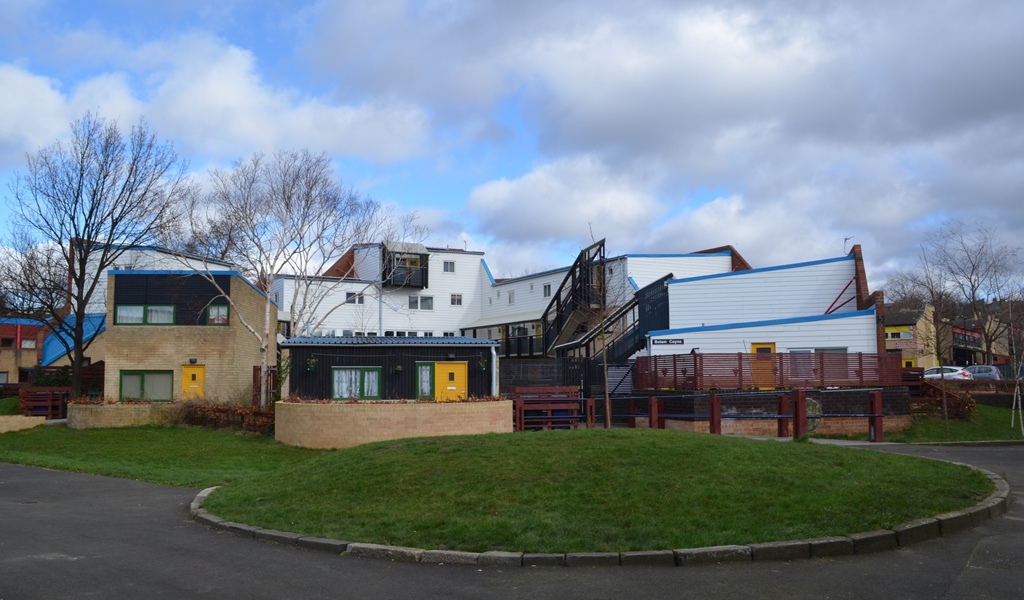Byker: Postcode NE6 2DJ
Where is it? Bing map|| Geograph grid ref NZ2764 || Ward profile || StreetCheck
- The Grade II listed Byker Estate in Newcastle upon Tyne was awarded ‘The Great Neighbourhood’ Award at the Academy of Urbanism Awards 2018 [Nov 2017]
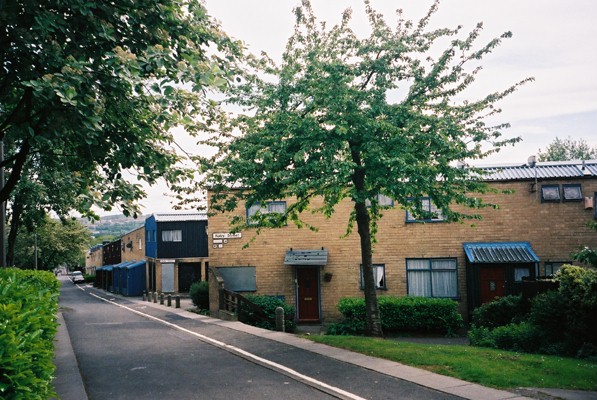
Responding to change
It was recognised that some things needed to change if Byker was to have a positive future in the twenty-first century. Among the options for Byker suggested in a 2001 council report were to hand the whole estate over to a private developer as a redevelopment scheme, to turn parts of it into a sheltered housing scheme or to turn it into student accommodation. In 2007 the estate was listed. In February 2008 the city council approved a scheme for developers to build a mixed development of flats and houses on part of the estate, some for sale and some to rent.
However the biggest change in recent times has been the creation of the Byker Community Trust, to own and manage the estate, following a tenant vote in 2011. Following its creation, the BCT announced plans to invest millions, which started with an award-winning facelift for the famous Byker Wall (see below). An initial loan from Yorkshire Building Society provided access to £12 million but the Trust are able to borrow up to £26 million during the ten years from January 2015.
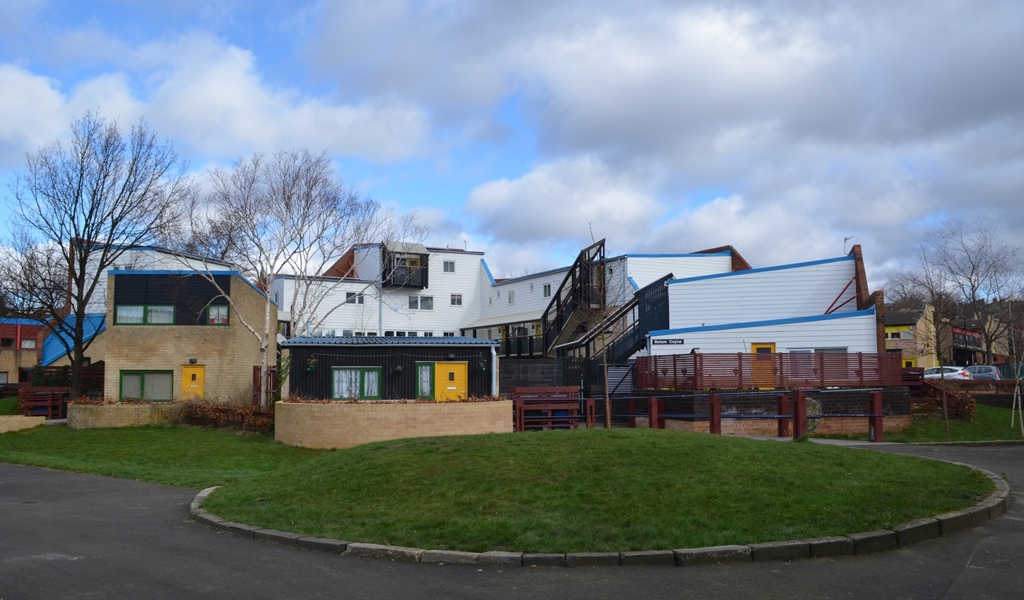
Bolam Coyne
The Byker Estate has had to evolve in response to changing social and environmental contexts. An example of this is the Bolam Coyne project (2010-12). Bolam Coyne was originally built by Ralph Erskine within the Byker Estate in the 1970s as a mixture of 17 one to four bed properties in a circular layout which made it difficult to meet the different needs of the people living there. In particular access via shared balconies caused problems. This led to properties being unlet and empty and attracted anti-social behaviour. It was recognised that it would be better to give people a little more private space and to group families and elderly people together rather than trying to mix them up.
Newcastle City Council decided to empty the properties in 2000. One suggested possibility was demolition to form a car parking area. Unfortunately Bolam Coyne then remained empty for ten years and was repeatedly vandalised.
The management company Your Homes Newcastle worked with Wates Living Space, English Heritage and Mike Drage (one of the original architects on the Byker estate) and this resulted in a new future for Bolam Coyne turning it into 15 two and three-bed sustainable family homes. Each of these homes has its own ground level front door. These homes were made available to rent in February 2012.
The Bolam Coyne project won the regeneration category at the Royal Institute of Chartered Surveyors North East Renaissance Awards 2013.
- Bolam Coyne project (Ryder Architects) http://www.ryderarchitecture.com/projects/bolam-coyne-refurbishment.htm
- Bolam Coyne project (WR Dunn & Co architects) http://www.wrdunn.co.uk/case-studies/residential/124-bolam-coyne
- BBC News story (Feb 2012) http://www.bbc.co.uk/news/uk-england-tyne-17145155
- Before pictures http://bolampics.blogspot.co.uk/
- Future Communities case study (Byker decline and recovery) http://futurecommunities.net/case-studies/byker-estate-newcastle-1967-present
- Byker retrospective (Newcastle Chronicle Oct 2016)
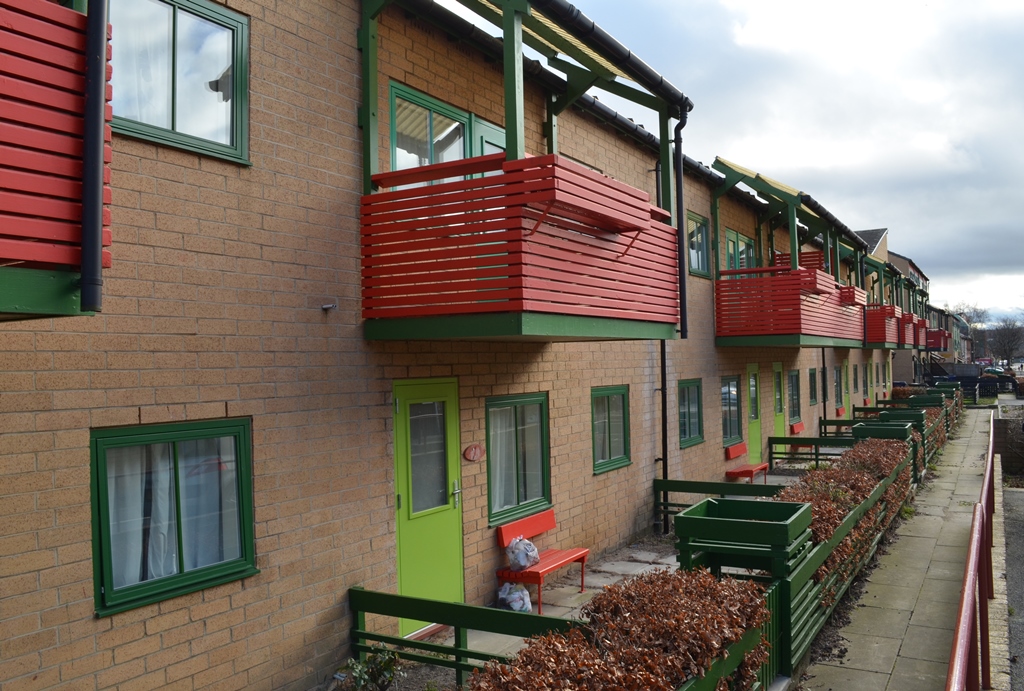
Listing
In January 2007 the Department for Culture, Media and Sport announced Byker had been Grade II* listed. Then Minister David Lammy said:
“The Byker estate is an extraordinary and outstanding piece of architecture which has won awards and attracted attention throughout its life. Its influence, both on design and the way we involve communities in the planning process, has been profound. It is right that it should now get the extra protection that listing provides. But listing does not mean that a building should be preserved unaltered for all time. Rather, it is a marker that the estate is important and decisive in its architectural influence, deserving special consideration if development plans ever come forward.” Government press release Jan 2007 (no longer available)
Listing meant that sustainable solutions had to be found for Byker and the regeneration of the estate had to be done in a sensitive way. Knocking down parts of it to rebuild or reuse land was no longer likely (an option before listing).
“The high design specifications of the buildings have made it very expensive to refurbish. Grade II listed status has both ensured that these specifications must be maintained, and opened up the possibilities of funding from heritage organisations to meet their high costs.” Future Communities
- Byker retrospective (Newcastle Chronicle Oct 2016) following the refurbishment of the Wall.
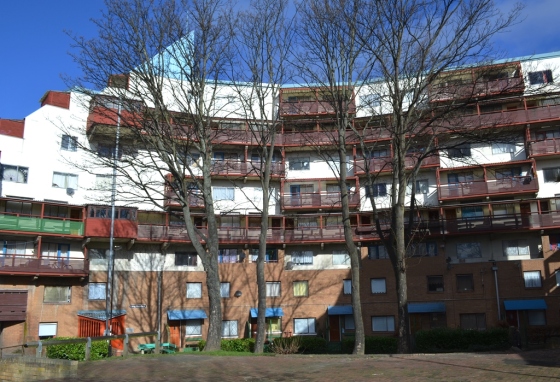
Byker Community Trust 2012 onwards
In July 2011 tenants on the Byker Estate voted overwhelmingly for a Community Trust to own and look after the estate on behalf of its residents.
“The Byker Community Trust has taken over ownership of 1,800 homes on the estate. And thanks to a £12m funding deal with Yorkshire Building Society, the trust has financial certainty for the next five years to help deliver much-needed investments to the Grade II-listed estate.” Newcastle Evening Chronicle 18 July 2012
The BCT now manages the Byker housing estate and the Byker investment programme. It took the lead on future development opportunities and provides a neighbourhood management service for the estate. The Trust is managed by a Board including community representatives, independent specialists and stakeholders such as the council and Your Homes Newcastle. Since it started it has evolved and now has a Performance and Services Committee, which includes Tenant Board Members, to oversee the operational performance of BCT. The first annual BCT Tenants’ Conference was held in October 2016; around 100 people attended.
- Byker Community Trust website http://www.bykercommunitytrust.org/
A tenure and property survey undertaken by the BCT in 2012 lists 1985 properties, 1805 of which are managed and let by the Trust. All of the 152 freehold properties were houses. There were a small number of bungalows and bedsits, but most properties were houses (46%), flats (27%) or maisonettes (25%). The majority of BCT properties are on the district heating scheme (this means tenants pay a weekly rent plus a set amount for heating). [Source: BCT Property and tenure summary 2012 no longer available]
Revitalising Byker Wall
In summer 2013 the BCT was able to announce a £7 million facelift for the famous Byker Wall. This is part of a longer-term package of £24 million of improvements planned over a five-year period.
Jill Haley, chief executive of the BCT, said: “The refurbishment of the wall was one of our key promises to the people of Byker when we asked them to vote on how the estate should be owned and managed. It will be the most significant investment made to the Byker Wall in its history. … We are focused on delivering significant investment in Byker that not only achieves the required physical improvements, but is also used to deliver improved life chances, with opportunities for programmes and training that will provide new skills, apprenticeships and jobs. … By improving the economic and social conditions within the estate we hope to improve residents’ health and well-being. The improvements we are making to the wall will mean increased energy efficiency for residents and we are looking forward to the end result adding to the legacy of the Byker Estate.” http://www.chroniclelive.co.uk/news/north-east-news/newcastles-historic-byker-wall-estate-4327219
At the beginning of April 2014, housing minister Kris Hopkins officially launched the refurbishment project, starting with Byker Crescent. The £9.7 million programme to upgrade 628 flats and maisonettes won a refurbishment award at the January 2018 Newcastle City Council Lord Mayor’s Design Awards.
The works included “…the installation of a new roof and photovoltaics, new windows and doors, improvements to communal stairwells and entrances, a new digital aerial system, upgraded door entry and CCTV and a complete repaint in line with the original Ralph Erskine colour scheme. …the removal of 300 tonnes of asbestos and the installation of fibre optic cabling for telephone and broadband services to 628 homes…” BCT news release Jan 2018
- 2017 BCT annual report (pdf) including the refurbishment and further plans.
Other BCT projects
The BCT website includes a number of other initiatives since the community trust was formed. Chirton House, a former care home, was converted into new flats for older people to rent and Avondale House converted to form transitional housing for armed forces veterans (34 one-bedroom flats). A breakfast club sponsored by Greggs bakery was set up at St Lawrence Primary school. Advice workers provide help with budgeting, information on benefit changes and there’s a weekly payment scheme, Own Your Own, to help with larger household purchases such as cookers, fridges and washing machines. Ten unused hobby rooms have become new homes for rent, two of which provide disabled adapted accommodation. Refurbishment of hobby rooms for use by the community and/or social enterprise is planned.
- Avondale House, Byker https://bykercommunitytrust.org/investment-programme/avondale-house/
- Avondale House https://www.afvg.co.uk/launchpad/living-at-avondale-house/
- Chirton House, Byker https://bykercommunitytrust.org/investment-programme/chirton-house/
The housing context
The demand for rented accommodation in Byker was depressed throughout the 1990s and up to 2003. There had been a general decline in demand to rent council housing across Newcastle upon Tyne city. In some parts of the Byker estate it had been suggested it may be possible to convert dwellings into family homes with defined gardens for which there was greater demand. It should be noted that house prices in Newcastle have been lower than many other British cities and there has been a good supply of rented housing in more upmarket areas such as Heaton and Jesmond where there has been considerable gentrification.
In the twenty-year period 1995-2015 house prices have risen considerably but not always steadily. In Newcastle between 2002 and 2006 homes for first-time buyers doubled in price. The demand for rented housing rose as many people were priced out of buying a house. In the urban parts of Tyneside there were peaks in 2005 (£150,000 in Newcastle) and 2008 (£176,500). Only in the third quarter of 2015 did prices in Newcastle exceed 2008 levels (£176,000 plus) [see graph].
The council responded to the increased demand for affordable housing by proposing a mixture of schemes in its 2006 housing strategy document (2006-2021) including social rented and low cost ‘market’ housing (i.e. for sale). Demand for affordable rented accommodation has increased since 2006, although house prices declined sharply in 2007-8 and were slow to recover.
Changes to housing benefits have meant that some tenants have had to downsize to homes with fewer rooms as a result of the so called ‘bedroom tax‘. New rules introduced in April 2013 have meant that a tenant who is paying rent for an under-occupied dwelling with ‘spare’ rooms couldn’t get benefit to cover all of the cost of the rent. This made two-bedroom properties in the Byker estate more attractive.
The Byker Community Trust has also helped tenants facing difficulties to find smaller properties which has had the knock-on effect of making more of the three and four-bedroom homes families seek become available.
“These are properties in good repair and many of them have been fully refurbished over the last 10 years. They will also be newly decorated, providing a blank canvas for tenants to transform into homes.” Jill Hayley BCT (press release 20 Feb 2014)
Universal Credit (UC) was rolled out in Newcastle during February 2017, a new welfare benefit which replaced a number of benefits including Housing Benefit. BCT offer support to tenants making benefit applications. Tenants also get help to manage their rent account to ensure they do not fall into arrears (via Karbon Homes staff).
All of these changes mean homes in Byker are more in demand than they were in the 1990s. Available properties are advertised on the Tyne and Wear Homes social housing website each week on a Thursday with the bidding closing on a Monday night.
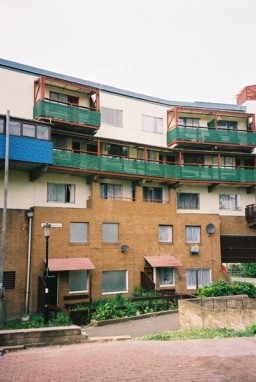
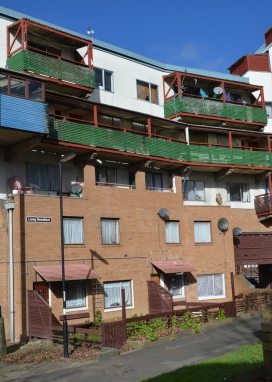
- What life is like in the ‘truly unique’ Byker Wall estate [Chronicle feature 9th Feb 2020]
- ‘This is Byker’ based at Byker Community Centre (BBC)
- Thriving Byker Strategy (Jan 2020) https://bykercommunitytrust.org/unique-byker-partnership-has-positive-impact-on-local-community/
Other local developments
The developments on the Byker estate are not the only housing initiatives in Byker. The Tyne Housing Association has been behind a number of social housing developments locally. These include a major conversion project on Shields Road and 42 one-bedroom flats under Byker Bridge in the nearby Ouseburn Valley (Farm View). The charitable association is well known for its work with vulnerable groups. It operates the Joseph Cowen healthcare centre in Wilfred Street, Byker, which specialises in helping homeless people.
- Beavan’s department store was one of the main retailers on Shields Road but the disused listed building (c.1910) had become run down. Tyne Housing Association converted the upper floors into 29 modern flats (£2.7m invested). The Journal (9 Oct 2009) http://www.thejournal.co.uk/news/north-east-news/conversion-breathes-life-former-beavans-4471028
- First homes in more than 50 years built at Newcastle’s Ouseburn Valley Chronicle news story Jan 2015 http://www.chroniclelive.co.uk/news/north-east-news/first-homes-more-50-years-8421592
